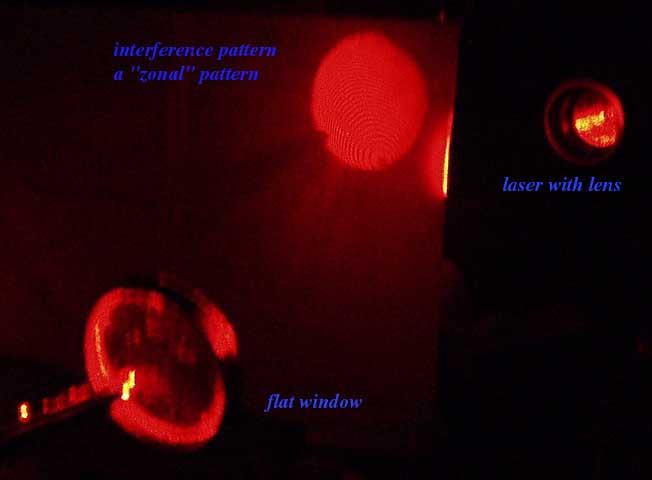
| OK, you have a
pointer laser,
batteries, a small fast lens, a flat window, and a piece of
paper.
Now you can setup to test your film's resolution, or just play.
This
method allows one to produce very fine lines with ease. Capturing
these lines on film produces simple holographic optical elements.
There are many ways to configure such experiments. This one uses a piece of 1mm thick filter glass to make fringes. If the glass is not flat (a microscope slide) the fringes will be a measure of the glass surface. Photographic filter glass is suitable for this purpose. |

| The laser beam
(~635nm) is diverged using
a small fast lens (3-15mm fl shown in upper right) and used to
illuminate a flat window(lower left).
The reflections from the window surfaces'
is directed to a white
card (top center). Destructive and constructive interference of
the wave of laser light from the two surfaces create these
fringes.
Rotate the widow until fringes are observed, or direct the two
reflected beams back towards the source.
The fringes are
curved because
the light from point source is a spherical wavefront interfering with
another
spherical wavefront. These are the reflections of the point source from
the front and rear surfaces of the flat window.
|

| A nice thing about
this pattern
is that many line spacings are produced. It is easy to place an
SLR
body with no lens to catch these rays and expose the film. Do not
look
into the viewfinder of the camera as it is too bright for safe viewing
(<16% of ~5 mw). It is necessary to hold the shutter open and
unblock the beam
to avoid camera movement during exposure.
One could use a 45 degree prism or wedge to intersect collimated beams at 22 degrees to produce about 500 lp/mm of non-curved lines. One could test lenses by shooting such fine patterns. Or they can test film resolution. But testing film is a boring exercise unless one craves the answer (or needs it). This is a simple way to do holography at home. Kodak Tech Pan film can record a 20 degree off axis transmission hologram. Higher resolution plates, like Slavich plates will work even better. One can produce reflection holograms using a pointer laser using these plates. Home holography is a
fun pastime.
New methods of processing and low cost lasers make this more attractive
than ever. Check our Richard's holography pages for further
guidance: |
| Testing the
films resolution is accomplished by illuminating the film with the
pattern and processing the film. A narrow beam directly from the
laser illuminates the pattern. The angle that the beam is
diffracted is a function of Bragg's law. If you don't get 22
degrees you are not recording 500 lp/mm. The diffraction
efficiency is related to recording efficiency that is related to the
contrast of the modulation function. So this also allows MTF
calculations. |
all
right reserved